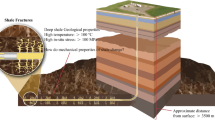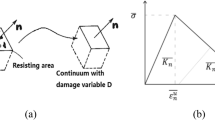Abstract
During the exploration and development of shale gas resources, elastic parameters provide crucial geomechanical information for shale gas extraction and hydraulic fracturing projects. Static elastic parameters are usually adopted in rock mechanics analyses and hydraulic fracturing designs and are generally obtained from experimental tests using core samples collected from the subsurface. However, experimental core data could be discontinuous despite the high costs. Dynamic methods, including well logging and seismic survey, are applied in practice. Given the difference between static and dynamic elastic parameters, dynamic elastic parameters gained from those aforementioned dynamic methods need to be converted to static elastic parameters. Currently, static and dynamic elastic parameter test data are often directly used in converting dynamic elastic parameters to static elastic parameters without consideration of the influence of rock mineral composition on the difference between elastic and dynamic elastic properties. Consequently, the conversion results cannot fully reflect reservoir geomechanical conditions. In this research, the rock mineral composition is analyzed, and the effects of various mineral components on static and dynamic elastic parameters of shale are discussed. A new conversion model is established by taking into account the rock mineral composition. The new model is capable of providing improved conversion results and thus can be applied in shale gas extraction and hydraulic fracturing projects at the target reservoir. Therefore, this research has both theoretical and practical impacts.







Similar content being viewed by others
References
Ameen MS, Smart BG, Somerville JM, Hammilton S, Naji NA (2009) Predicting rock mechanical properties of carbonates from wireline logs (a case study: Arab-D reservoir, Ghawar field, Saudi Arabia). Mar Pet Geol 26(4):430–444
Asef MR, Farrokhrouz M (2010) Governing parameters for approximation of carbonates UCS. Electron J Geotech Eng 15:1581–1592
Bian HY, Wang F, Zhang YH, Yue CW (2015) Experimental study of dynamic and static elastic parameters of tight sandstones under reservoir conditions. Chin J Rock Mech Eng 34(S1):3045–3054
Eissa EA, Kazi A (1988) Relation between static and dynamic Young's moduli of rocks. International Journal of Rock Mechanics and Mining & Geomechanics Abstracts 25(6):479–482
Ge X, Fan Y, Li J, Zahid MA (2015) Pore structure characterization and classification using multifractal theory—an application in Santanghu basin of western China. J Pet Sci Eng 127:297–304
Horsrud P (2001) Estimating mechanical properties of shale from empirical correlations. SPE Drill Complet 16(02):68–73
King MS (1983) Static and dynamic elastic properties of igneous and metamorphic rocks from the. Can Shield 20(5):237–241
Lacy LL (1997) Dynamic rock mechanics testing for optimized fracture designs. In SPE annual technical conference and exhibition. Society of Petroleum Engineers
Luangthip A, Wilalak N, Thongprapha T, Fuenkajorn K (2017) Effects of carnallite content on mechanical properties of Maha Sarakham rock salt. Arab J Geosci 10(6):149
Ohen HA (2003) Calibrated wireline mechanical rock properties model for predicting and preventing wellbore collapse and sanding. In SPE European Formation Damage Conference. Society of Petroleum Engineers
Qiao X, Zhao C, Shao Q, Hassan M (2018) Structural characterization of corn stover lignin after hydrogen peroxide presoaking prior to ammonia fiber expansion pretreatment[J]. Energy Fuel 32(5):6022–6030
Saedi B, Mohammadi SD, Shahbazi H (2018) Prediction of uniaxial compressive strength and elastic modulus of migmatites using various modeling techniques. Arab J Geosci 11(19):574
Sun F, Yao Y, Li G, Li X, Lu C, Chen Z (2018a) A model for predicting thermophysical properties of water at supercritical state in offshore CDTW[J]. Measurement 124:241–251
Sun F, Yao Y, Li G, Li X, Zhang T, Lu C, Liu W (2018b) An improved two-phase model for saturated steam flow in multi-point injection horizontal wells under steady-state injection condition[J]. J Pet Sci Eng 167:844–856
Sun F, Yao Y, Li G, Li X (2019a) A slip-flow model for multi-component shale gas transport in organic nanopores. Arab J Geosci 12(5):143
Sun F, Yao Y, Li G, Zhang S, Xu Z, Shi Y, Li X (2019b) A slip-flow model for oil transport in organic nanopores. J Pet Sci Eng 172:139–148
Sun F, Yao Y, Li G, Li X (2019c) Transport zones of oil confined in lipophilic nanopores: a technical note. Arab J Geosci 12(4):136
Sun F, Yao Y, Li G, Dong M (2019d) Transport behaviors of real gas mixture through nanopores of shale reservoir[J]. J Pet Sci Eng 177:1134–1141
Sun F, Yao Y, Li G, Liu W (2019e) Simulation of real gas mixture transport through aqueous nanopores during the depressurization process considering stress sensitivity[J]. J Pet Sci Eng 178:829–837
Wang F, Bian HY, Gao XH, Pan BZ (2016) Application of fullbore formation microimager logging in the evaluation of anisotropic resistivity in a thin interbed reservoir. J Geophys Eng 13(4):454–461
Wang Z (2000) Dynamic versus static elastic properties of reservoir rocks. Seismic and Acoustic Velocities in Reservoir Rocks 3:531–539
Weast RC, Astle MJ, Beyer WH (1988) CRC handbook of chemistry and physics (Vol. 69). CRC press, Boca Raton
Zhao B, Liu D, Liu W (2018) Mechanical behavior of sandstone under uniaxial constant cyclical compressive and tensile loading. Arab J Geosci 11(17):490
Zhao C, Qiao X, Cao Y, Shao Q (2017) Application of hydrogen peroxide presoaking prior to ammonia fiber expansion pretreatment of energy crops. Fuel 205:184–191
Zhu D, Jing HW, Yin Q, Zong YJ, Tao XL (2018) Experimental study on mechanical characteristics of sandstone containing arc fissures. Arab J Geosci 11(20):637
Zisman WA (1933) Comparison of the statically and seismologically determined elastic constants of rocks. Proc Natl Acad Sci U S A 19(7):680–686
Funding
This work was supported by the National Major Science and Technology Project (Grant No. 2017ZX05030-002), Scientific research plan projects of Education Department of Shaanxi (Grant No. 18JK0517), and the Exploration Utility Department 2017-Science-05 Project of Qinghai Oil Field Branch, National Science and Technology Major of PetroChina (Grant No. 2016E-0108GF).
Author information
Authors and Affiliations
Corresponding author
Additional information
Responsible Editor: Abdullah M. Al-Amri
Rights and permissions
About this article
Cite this article
Huiyuan, B., Wang, F., Chengen, Z. et al. A New Model between Dynamic and Static Elastic Parameters of Shale Based on Experimental Studies. Arab J Geosci 12, 609 (2019). https://doi.org/10.1007/s12517-019-4777-2
Received:
Accepted:
Published:
DOI: https://doi.org/10.1007/s12517-019-4777-2




